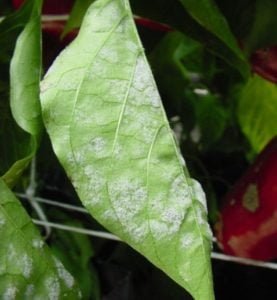Table of contents of the article
Toggle
Powdery mildew is a fungal disease that causes sweet pepper leaves to be covered with a white layer that affects the photosynthesis process. This article from the “WORLD OF PLANTS” website provides a comprehensive look at the symptoms of powdery mildew on sweet pepper leaves and methods of control.
Causes of powdery mildew on sweet pepper leaves
- Disease name: Powdery mildew on sweet pepper leaves
- Scientific name: Leavellula taurica
- Type of disease: fungal
- Disease family: Erysiphaceae
The pathogen of powdery mildew differs from that of powdery mildew in other crops in that it occurs primarily within the leaf rather than on the leaf surface. Powdery mildew can be severe during the warmer part of summer and can cause severe yield losses.
Symptoms of powdery mildew on sweet pepper leaves
The initial symptoms of powdery mildew on peppers appear as white, downy fungal growths on the undersides of the leaves, with light green to yellow spots on the upper leaf surfaces. These areas turn brown over time, causing a general yellowing of the entire leaf. The outer edges of the leaves may curl upward. Leaves can fall prematurely, leading to a loss of space for photosynthesis, which results in slowed plant growth and fruit development.
Powdery mildew development cycle on sweet pepper leaves
The fungus is spread by wind, in high humidity air conditions, which helps conidia germinate and spread the infection in the plant.
Suitable conditions for the spread of powdery mildew on sweet pepper leaves
It needs mushrooms Leavellula taurica High humidity levels of more than 85% and temperatures ranging between (15-25) degrees Celsius, which are ideal conditions for mushroom growth on pepper plants.
Losses resulting from the spread of powdery mildew on sweet pepper leaves
Powdery mildew causes a decrease in production as a result of the fall of leaves and the loss of the photosynthetic zone, which prevents plant growth and fruit development. Fewer flowers are formed on severely infected plants and may also fall. Additional losses resulting from sunburn of fruits are also formed as a result of falling leaves.
Controlling powdery mildew on sweet pepper leaves
- Apply fungicides during the early stages of infection, to control it and reduce economic losses. Spraying is effective when applied with high pressure and a large amount to achieve optimal penetration of the crop canopy with the fungicide.
- Spraying the crop with sulfur and potassium bicarbonate on the pepper crop.
- Isolate the infected plant to avoid spreading the infection in the crop.
Preventive measures for powdery mildew on sweet pepper leaves
- Getting rid of plant remains and branches on the farm, as they are a source of germs.
- Providing a good irrigation and drainage system for the crop.
- Good fertilization enhances the plant’s resistance to diseases.
- Use disease-resistant varieties.
- Sterilize agricultural tools before use to avoid transmission of infection from one plant to another.
In conclusion, we would like to note that we, at the world of plants website, offer you all the necessary services in the world of plants, we provide all farmers and those interested in plants with three main services::-
- Artificial intelligence consulting service to help you identify diseases that affect plants and how to deal with them.
- Blog about plants, plant diseases and care of various crops ... You are currently browsing one of her articles right now.
- An application that provides agricultural consultations to clients, as well as a service for imaging diseases and knowing their treatment for free – Click to download the Android version from Google Play Store، Click to download the IOS version from the Apple App Store.




